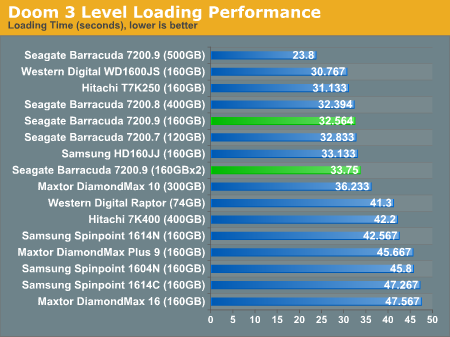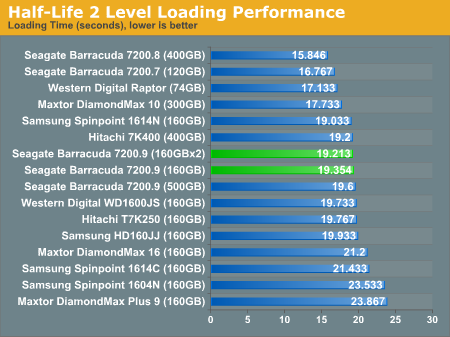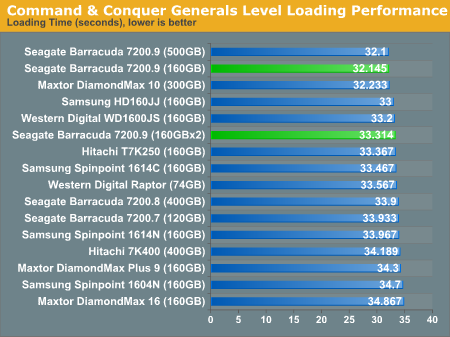Seagate 7200.9 160GB: The Highest Platter Density to Date!
by Purav Sanghani on January 31, 2006 10:29 PM EST- Posted in
- Storage
Real World Tests - Multitasking Performance
To provide a real world example of multitasking, we run Outlook and import 450MB of emails into an account. We then time how long it takes our benchmarking utility to zip a single 300MB file. To compare our results, we calculate the difference between the multitasked process and the single task file zip process.
Real World Tests - Application Load Times
In our Application Load Time tests, we measure the time that it takes for each application to startup. For example, our benchmarking tool begins the stopwatch as soon as PhotoShopCS.exe is run and stops after the application has finished loading all of the plug-ins and filters and shuts down. We take the average of 3 runs with system reboots and hard disk defragmentations before each test run.
The higher density platters of the 160GB unit prove to perform slightly faster when loading the Office 2003 application suite as well as the Photoshop CS imaging software. RAID-0 does not help here at all, but does very little to hurt.
Game Level Load Times
Our Game Level Loading Time tests include two of the latest games: Doom 3 and Half-Life 2. Because of their high resolution textures and the large levels, the loading time for the levels of each game are long enough to help show a difference between each drive.
We have also included an older strategy game, Command & Conquer: Generals, because of its longer level load times as well. Though the game is a couple of years old, it still proves to be a good measure of data loading performance.
To provide a real world example of multitasking, we run Outlook and import 450MB of emails into an account. We then time how long it takes our benchmarking utility to zip a single 300MB file. To compare our results, we calculate the difference between the multitasked process and the single task file zip process.
| Outlook + Zip a 300MB File Within Drive | ||||
| Multitasked | File Zip Only | % Difference | ||
| Seagate 7200.9 160GB | 78.624 | 65.715 | 19.6% | |
| Seagate 7200.9 160GB (2-Drive, RAID-0) | 68.546 | 58.693 | 16.8% | |
| Hitachi T7K250 160GB | 79.815 | 65.641 | 21.6% | |
| Samsung HD160JJ 160GB | 73.554 | 61.068 | 20.4% | |
| Western Digital WD1600JS 160GB | 74.371 | 61.182 | 21.6% | |
| Seagate 7200.9 500GB | 69.512 | 59.785 | 16.3% | |
Real World Tests - Application Load Times
In our Application Load Time tests, we measure the time that it takes for each application to startup. For example, our benchmarking tool begins the stopwatch as soon as PhotoShopCS.exe is run and stops after the application has finished loading all of the plug-ins and filters and shuts down. We take the average of 3 runs with system reboots and hard disk defragmentations before each test run.
| Application Load Times (average, seconds) | |||||
| PhotoShop CS | Word 2003 | Excel 2003 | Access 2003 | PowerPoint 2003 | |
| Seagate 7200.9 160GB | 7.454 | 1.109 | 1.125 | .968 | 1.109 |
| Seagate 7200.9 160GB (2-Drive, RAID-0) | 7.544 | 1.171 | 1.140 | 1.125 | 1.000 |
| Hitachi T7K250 160GB | 7.984 | 2.375 | 2.609 | 2.766 | 2.109 |
| Samsung HD160JJ 160GB | 8.601 | 2.554 | 2.887 | 3.115 | 2.245 |
| Western Digital WD1600JS 160GB | 8.938 | 2.469 | 2.562 | 2.484 | 2.438 |
| Seagate 7200.9 500GB | 8.024 | 1.687 | 1.718 | 1.640 | 1.593 |
The higher density platters of the 160GB unit prove to perform slightly faster when loading the Office 2003 application suite as well as the Photoshop CS imaging software. RAID-0 does not help here at all, but does very little to hurt.
Game Level Load Times
Our Game Level Loading Time tests include two of the latest games: Doom 3 and Half-Life 2. Because of their high resolution textures and the large levels, the loading time for the levels of each game are long enough to help show a difference between each drive.
We have also included an older strategy game, Command & Conquer: Generals, because of its longer level load times as well. Though the game is a couple of years old, it still proves to be a good measure of data loading performance.













23 Comments
View All Comments
yacoub - Thursday, February 2, 2006 - link
If you're going to do an acoustics test, you should make a useful graph instead of that tiny one that makes them all look relatively equivalent in noise output. You should also note any particular sound properties the drive emits. Whine, pitch, vibration, etc. It would be subjective but it's also very important.If anything, harddrive speed and performance are relatively similar among most drives. The noise output however, is often greatly different, and is especially important if the drive emits noise at a certain frequency that annoys the user. I'd rather wait an extra millisecond for a seek than have to put up with a constant ringing noise or whine from the drive.
You could also at least include a modern Samsung SpinPoint like the P120 SP2004C 200GB drive in your test list instead of the dated Samsungs you use currently. Aside from it having better performance than most of the older Samsungs you list, it also is one of the quietest 7200rpm 3.5" HDs out there - enough that it would certainly stand out in your acoustics test instead of the current lot you test with that leaves a graph that gives a false impression of "oh, looks like all HDs are about the same in noise so I won't bother using that as a purchase consideration."
http://www.storagereview.com/articles/200511/SP250...">http://www.storagereview.com/articles/200511/SP250... shows a more useful acoustics test graph and the strongest point of the Samsung SpinPoint SP2004C - its SPL. Anyone building a quiet PC should certainly consider it. I love mine.
SilentPCReview also has a SpinPoint P120 SP2004C review but their site seems to be down at the moment.
RallyMaster - Wednesday, February 1, 2006 - link
Is this the ST3160812AS? If so...I have one! Never thought my 95 dollar hard drive was capable of doing so well. Wow.wharris1 - Wednesday, February 1, 2006 - link
yes, this article was initially posted last week.Olaf van der Spek - Wednesday, February 1, 2006 - link
> We also benchmarked a couple of these drives in a RAID-0 array as a brief look at RAID performance with results that were pleasing to our eyes.Really?
No improvements in either application or game level load times.
Little improvements in the zip/unzip tests.
What exactly is so pleasing?
Results in vague iPeak tests?
JWalk - Tuesday, February 7, 2006 - link
Ding! We have a winner.Nothing appears to have changed when it comes to real-world applications and RAID-0 performance. Anand himself and Eugene at storagereview.com have settled this numerous times.
If you want to see big synthetic benchmark numbers, run RAID-0. If you want actual real-world results, use a fast single drive. RAID has its place, but not in a RAID-0 array for normal desktop/gaming use.
Ecmaster76 - Tuesday, January 31, 2006 - link
Did this one get pulled and put back up or something?neogodless - Tuesday, January 31, 2006 - link
I think the focus on RAID makes the omission of temperature and noise data a strange thing. How does that second drive affect the temperature inside the case, especially if the drives are side by side? How does it affect noise?patentman - Friday, January 27, 2006 - link
"With the announcement and release of Seagate's new 160GB 5400.3 2.5" notebook drive, which utilizes the new perpendicular magnetic recording method"I think I've said this before, but perpendicular magnetic recording is not new by any stetch of the imagination. There are patents on this technology that were filed in the late 80's. Mainstream products using this technology might be new, but the actual method of recording is, in the computer world, very very old.
PuravSanghani - Wednesday, February 1, 2006 - link
Patentman,Though the patent may have been around since the late 80's, only recently has a hard drive manufacturer been able to implement the technology in their products.
Toshiba was the first to do this with their smaller drives and Seagate is the first do implement this technology in notebook drives. The race is on to see who will introduce desktop drives based on this technology!
Purav
Mr Perfect - Friday, January 27, 2006 - link
The 160GB 7200.9 is not in either of the two temperature charts or the noise chart. The 500GB 7200.9 is there, but no it's little brother.